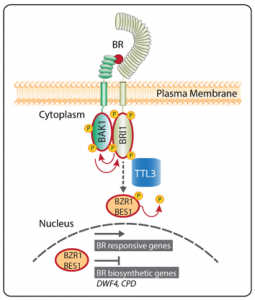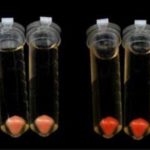Scaffolding Brassinosteroid Components to Improve Plant Growth
Amorim-Silva et al. identify scaffolding proteins that optimize BR signaling. Plant Cell https://doi.org/10.1105/tpc.19.00150
By Vitor Amorim-Silva and Miguel Botella
Background: The plant hormone Brassinosteroid (BR) is essential for proper growth. This hormone is extracellularly perceived by plasma membrane Receptor Like-Kinases, causing transphosphorylation of their cytosolic domains and the subsequent phosphorylation/dephosphorylation of signaling components. These events lead to the activation of key transcription factors, which in turn activate the transcription of multiple genes that enhance plant growth. Although most of the core signaling components have been identified, we know little about how these components associate to optimize signaling.
Question: We previously observed that the plant-specific TETRATRICOPEPTIDE THIOREDOXIN-LIKE (TTL) genes, whose encoded proteins contain protein–protein interaction domains, are involved in abiotic stress tolerance. In this work, we aimed to determine whether these proteins are positive regulators of BR signaling and could serve as a scaffold of BR components to optimize signaling.
 Findings: We found that mutations in these TTL genes caused marked defects in BR responses. Protein interaction studies indicate that TTL proteins either interact or associate in vivo with most core BR signaling components. Cellular studies of Arabidopsis plants transformed with a functional TTL3-GFP protein indicate that while TTL3-GFP is mainly localized at the cytosol, treatment with exogenous BR caused an increased localization of this protein at the plasma membrane. On the other hand, reducing the amount of endogenous BR caused dissociation of TTL3-GFP from the plasma membrane. Furthermore, expression of TTL3 strongly increased the plasma membrane association of a plasma membrane and a cytoplasmic BR signaling component. Taking all this together, we propose that TTLs function as a scaffold that increases the concentration of BR components at the plasma membrane and thereby optimizes BR signaling.
Findings: We found that mutations in these TTL genes caused marked defects in BR responses. Protein interaction studies indicate that TTL proteins either interact or associate in vivo with most core BR signaling components. Cellular studies of Arabidopsis plants transformed with a functional TTL3-GFP protein indicate that while TTL3-GFP is mainly localized at the cytosol, treatment with exogenous BR caused an increased localization of this protein at the plasma membrane. On the other hand, reducing the amount of endogenous BR caused dissociation of TTL3-GFP from the plasma membrane. Furthermore, expression of TTL3 strongly increased the plasma membrane association of a plasma membrane and a cytoplasmic BR signaling component. Taking all this together, we propose that TTLs function as a scaffold that increases the concentration of BR components at the plasma membrane and thereby optimizes BR signaling.
Next steps: Our work has shown that TTL genes, which were initially identified as having a role in salt tolerance based on genetic studies, function in BR responses. Whether their contribution to salt tolerance is mediated by their role in BR signaling, in other signaling pathways, or as scaffolding components remains to be established. Genetic determinants with a role in growth and stress tolerance may have important biotechnological applications, particularly considering that TTL genes are conserved in all major crops.
Vítor Amorim-Silva, Álvaro García-Moreno, Araceli G. Castillo, Naoufal Lakhssassi, Alicia Esteban del Valle, Jessica Pérez-Sancho, Yansha Li, David Posé, Josefa Pérez-Rodriguez, Jinxing Lin, Victoriano Valpuesta, Omar Borsani, Cyril Zipfel, Alberto P. Macho, Miguel A. Botella. (2019).
TTL Proteins Scaffold Brassinosteroid Signaling




